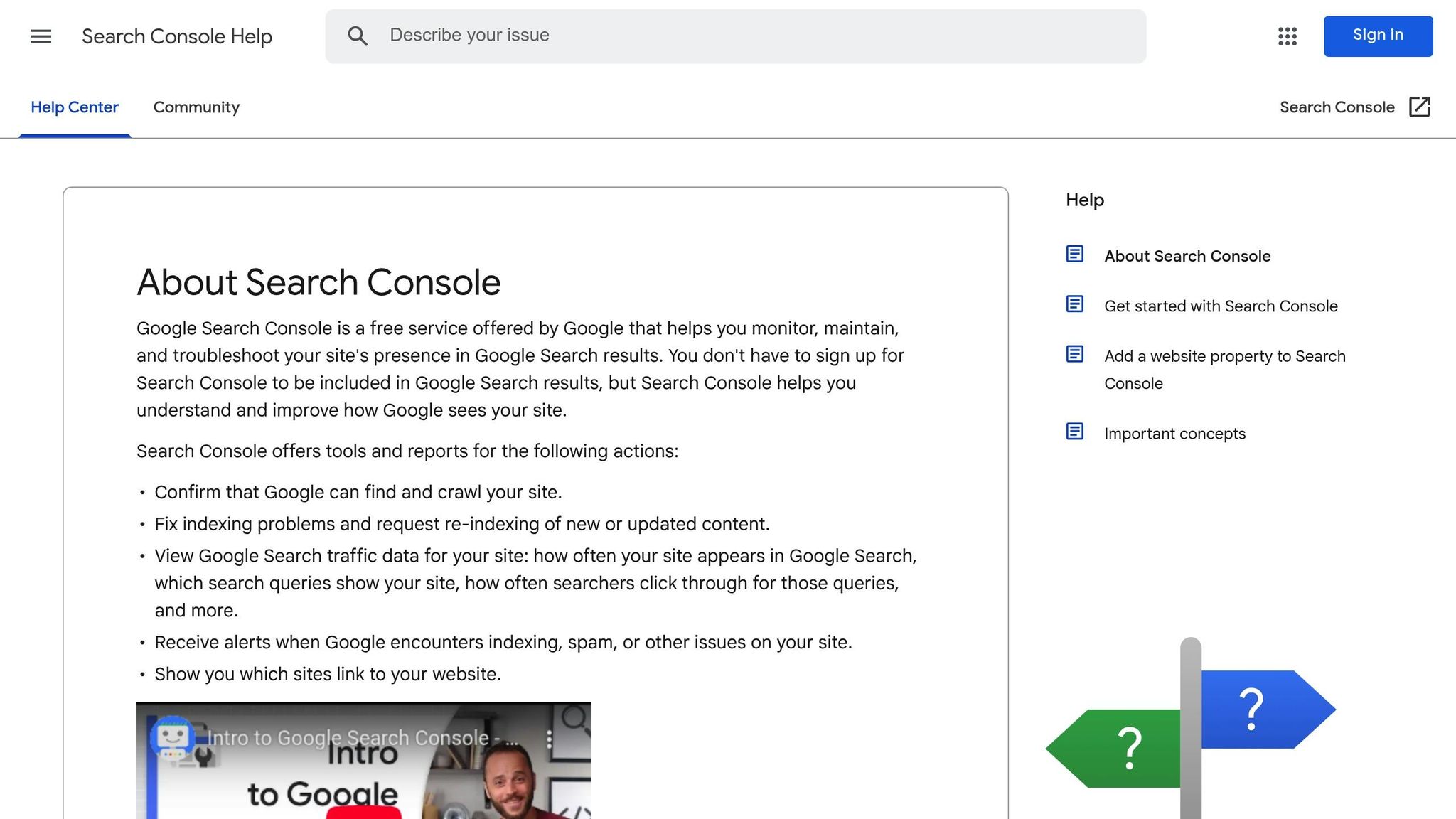Google can index pages even if they’re blocked by your robots.txt file. This happens when pages are linked elsewhere or were previously indexed. While these pages appear in search, Google can’t crawl their content, which can hurt rankings.
Here’s how to fix it:
- Identify Problem Pages:
- Use Google Search Console → Coverage Report → Filter for "Indexed but blocked by robots.txt."
- Export the list of affected URLs.
- Check Blocking Rules:
- Test URLs in the robots.txt Tester to find the blocking directives.
- Look for overly broad
Disallowrules, like:Disallow: /products/
- Update Your Robots.txt:
- Edit the file to allow important pages:
Allow: /products/ - Save changes and upload the updated file to your server.
- Edit the file to allow important pages:
- Verify Changes:
- Use the robots.txt Tester to confirm fixes.
- Submit affected URLs for recrawling in Google Search Console.
- Prevent Future Issues:
- Regularly audit your robots.txt file.
- Keep rules specific and consistent.
- Monitor Google Search Console for new warnings.
Fix Indexed, Though Blocked By Robots.txt Google Search …
Finding Problem URLs
Blocked pages can negatively impact your rankings, especially if they hold high value. It’s crucial to identify these problem URLs and address them quickly.
Google Search Console Steps

To start, open Google Search Console and navigate to the Coverage report. Apply the filter for "Indexed but blocked by robots.txt" and export the list of affected URLs using the Export button.
Checking URL Block Status
Here’s how to determine if URLs are being blocked and why:
- Use the robots.txt Tester
In Google Search Console, access the robots.txt Tester. Enter the URLs you want to check. This tool will show if a URL is blocked and highlight the specific rule responsible. - Identify URL Patterns
Common patterns of blocked URLs include:- Product pages
- Parameterized category pages
- Date-based archives
- Search or result pages
- Admin areas
- Verify Current Status
Use these methods to confirm the current status of blocked URLs:- Live check: Use the robots.txt Tester to confirm if a URL is currently blocked.
- Cache check: View the last crawl date using Google Cache.
- Index check: Use a
site:query in Google to see if the URL is indexed.
Focus on unblocking high-priority pages, such as product pages or cornerstone content, to avoid ranking issues.
The next step is learning how to modify your robots.txt file to allow access to these important URLs.
Fixing Blocked URLs
To address blocked URLs, you’ll need to adjust the rules in your robots.txt file. Here’s how:
Edit Your Robots.txt File
Find your robots.txt file at the root of your domain (e.g., www.yoursite.com/robots.txt). Before making changes, create a backup of the file.
To unblock URLs, you can remove Disallow directives, add Allow rules, or refine overly broad Disallow patterns. Here’s an example:
# Original blocking rule Disallow: /products/ # Modified to allow specific product pages Disallow: /products/admin/ Allow: /products/ You can access the robots.txt file using your hosting provider’s file manager or an FTP client. If you’re using a CMS, check its documentation for guidance.
Check Your Changes
- Paste the updated
robots.txtfile into the robots.txt Tester in Google Search Console. - Verify that previously blocked URLs are now accessible.
- Address any syntax errors flagged by the tool.
Update Live Robots.txt
- Upload the updated
robots.txtfile to your server, clear your CDN cache, and confirm the changes by visitingyourdomain.com/robots.txt. - Submit the affected URLs in Google Search Console for recrawling.
- Keep an eye on the Coverage report in Search Console; it may take a few days for the changes to fully reflect.
sbb-itb-880d5b6
Avoiding Future Errors
Once you’ve resolved current issues, it’s important to adopt practices that help prevent indexing problems down the road.
Keep Formatting Consistent
- Use lowercase paths, include a sitemap directive, and arrange rules based on specificity.
- Consistent rules help avoid misconfigurations and accidental blocks.
- This also prevents case-sensitive path mismatches that could block key content.
Use Version Control for Robots.txt
- Commit every change, tag releases, and maintain a detailed changelog for accountability.
- This allows quick rollbacks if any blocking issues arise.
- Integrate the file into your CMS deployment process to catch potential problems before publishing.
Plan Monthly Audits
- Use tools like the robots.txt Tester to validate directives and review Google Coverage reports.
- Regular audits help catch newly added disallow rules that could block critical pages.
- Ensure your crawl permissions align with your indexing goals.
Conduct Routine Reviews
- Set reminders to review robots.txt monthly.
- Compare current rules with your site’s URL structure.
- Watch Google Search Console for "Indexed but blocked" warnings.
- Keep a record of any updates made during these reviews.
Stick to Robots.txt Best Practices
- Write simple, specific rules.
- Add clear comments to explain complex directives.
- Use consistent spacing and formatting for better readability.
- Always test changes in a staging environment before going live.
Advanced Solutions
When basic robots.txt edits and audits don’t fix all issues, you might need to turn to more specialized tactics. These approaches address tricky cases and quirks in content management systems (CMS) to better control crawl permissions.
Decide: Block or Unblock
Use your exported URL list from Search Console to decide whether to block or unblock specific pages. Here’s a quick guide:
| Criteria | Action |
|---|---|
| High-value content (e.g., products, articles) with external links | Unblock immediately; update robots.txt to "Allow" |
| Administrative or utility pages containing sensitive data | Keep blocked; ensure "Disallow" rules are in place |
| Pages with duplicate or low-quality content | Block if a canonical URL exists; unblock if the content is unique |
Update in Your CMS
Once you’ve decided what to block or unblock, you’ll need to implement the changes in your CMS. Here’s how to handle robots.txt updates in two popular platforms:
- Install an SEO plugin like Yoast or RankMath.
- Go to Tools → File Editor.
Access robots.txt via SEO → Tools → File Editor - Make your changes, save them, and clear your cache.
- Navigate to Online Store → Themes → Current Theme.
- Edit the robots.txt file in the
theme.liquidfile:{% render 'robots-txt' %} - Publish your changes and verify them in the Theme Editor.
For more complex or conditional blocking scenarios, you may need to explore additional advanced techniques.
Conclusion
Managing your robots.txt file correctly ensures search engines can crawl and index your site effectively. Here’s a straightforward way to tackle "Indexed but blocked by robots.txt" problems:
- Identify: Use Google Search Console to find URLs that are indexed but blocked.
- Evaluate: Decide which blocked URLs should be accessible and which can stay restricted.
- Update: Modify your robots.txt file to allow access to the necessary URLs.
- Verify: Recheck in Google Search Console to confirm the changes have resolved the issue.
Regularly reviewing Search Console reports helps you spot and fix new blocking problems, keeping your site’s crawlability and indexing in good shape. This approach ensures your most important pages remain accessible to Google.




